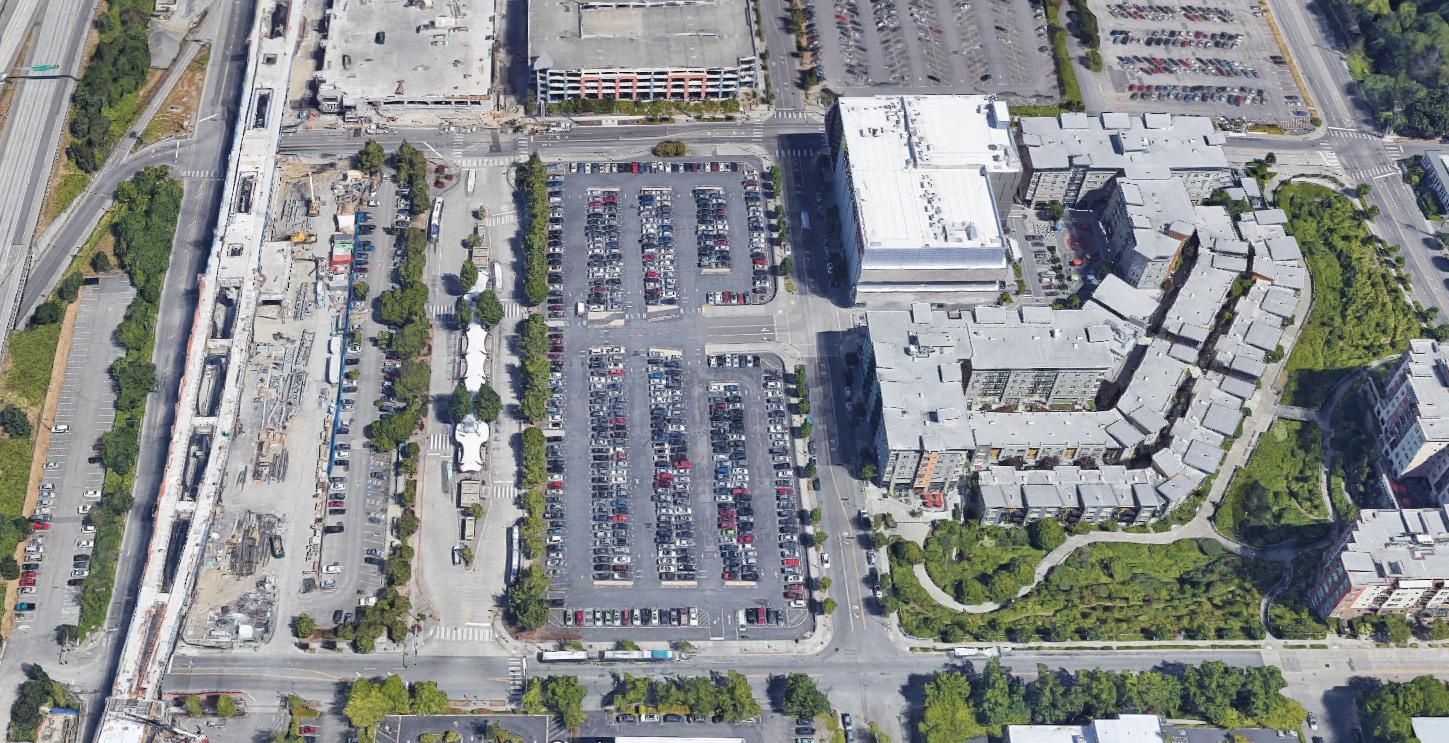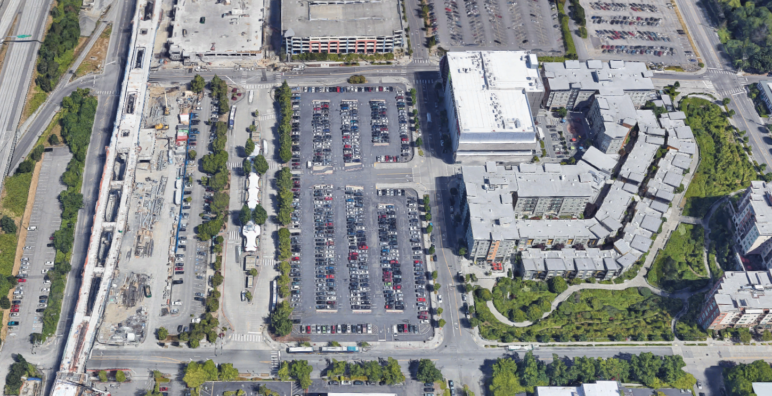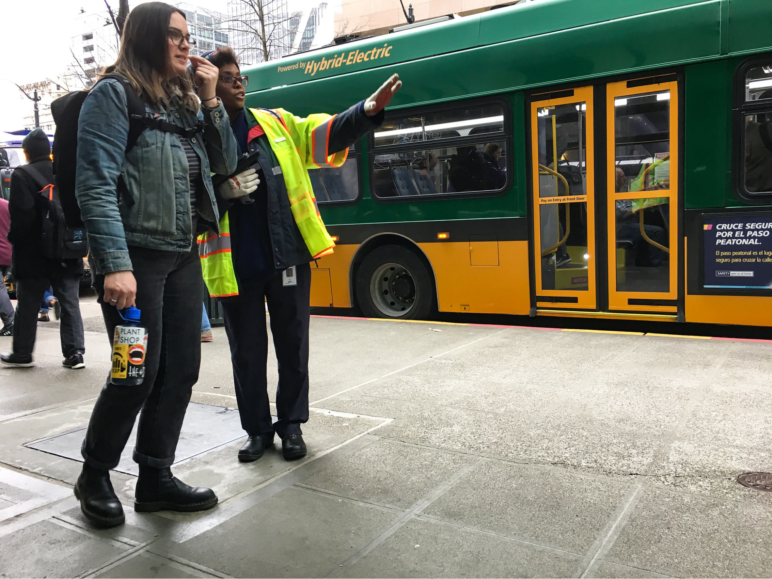Let’s say you were the kind of kid who rooted for Darth Vader in Star Wars, for the Joker in Batman, for Magneto in the X-Men. You’re determined to be a villain—heck, a supervillain. But now, as an adult, you’re in charge not of a legion of stormtroopers or a criminal syndicate. Instead, you somehow ended up running a regional transit agency. (Hollywood, call me.)
So here you are, aspiring to supervillainy but running transit. What is your malignant plot to secretly undermine the quality of your public transit service, help enshrine traffic and auto dependence in your growing community indefinitely, and otherwise release despair upon the world? What to do? Well, I’ll tell you, in two easy steps.
First, surround your major transit hubs with parking lots and garages: acres of them, hundreds and hundreds of slots. Set aside as much land as possible near the entrances to your multi-billion-dollar transit system for nothing but auto storage. Otherwise, that land will end up with apartments, shops, and offices, and that kind of densely clustered, walkable node will raise transit ridership. And that would be bad for your villainous, transit-sabotaging goals. It might even lead to more fare revenue for your transit agency and more public support for transit. You might start to see new businesses popping up nearby to serve all the people coming and going. Things could get all transity and low-carbon and prosperous, which would really put a wrench in your evil-doing.
Now to finish the job, here’s the second step in your scheme for undermining the expensive public transit system you control. If you want to be fully villainous, this one is absolutely crucial.
You’re going to have to give all the parking away for free.
Stick with me here.
I realize that, to anyone but a supervillain, it may sound bonkers to spend tens of millions of dollars on huge parking facilities like Seattle’s Northgate Transit Center—that will, like Northgate Transit Center, be completely full by early in the morning if you don’t charge for them—and then not charge for them.
I realize that it drives approximately half your potential users nuts that the only way to get into the garage is to forgo an hour of sleep in the morning.
I realize that if your hot dog stand were running out of hot dogs by 7 am every day, you would probably consider charging money for the hot dogs. There’s got to be something useful you could do with money, after all.
Yes, all of that is true. But charging for useful services and reinvesting the revenue on things that benefit everyone (and your poorer constituents disproportionately) is X-Men stuff. Sooner or later it leads to a greener, fairer and more efficient economy. So get with the nefarious program, buster, and hand that parking out on a first-come, first-served basis.
Because here’s what you need to understand: It’s not enough just to ring a transit station with giant parking lots. Sure, that’ll suppress long-term ridership compared with a cluster of homes and jobs. But if that parking is bringing in enough money to pay for itself, then it’s not actually going to suck resources away from your actual transit system. Do you see? Free parking is a way to quietly, secretly bleed your transit system dry! And—stop me if I’m wrong—you’re not one of those mediocre villains who only wants to prevent your transit system from getting better, are you? You’re a supervillain! You want to make service worse.
To do that, you’re going to need to ensure that the parking garages you build are massive money-losers that every user of your system will have to pay for in the form of less frequent, less reliable transit service. And the surest way to do that is for all that investment to bring in no money at all.
Mwahahaha.
King County Metro has a chance to advance its national reputation for transit excellence
OK, OK.
The truth, of course, is that nobody thinks like a supervillain. Public transit may or may not be your thing, but just about everybody wants it to work well.
But once we get used to something like free public parking lots near transit hubs, it can be hard for well-intentioned people to see the ways the status quo is being villainous. A lot of things in life are that way!
Fortunately, a council committee in King County—Cascadia’s most populous county by far, home to Seattle and to one of the nation’s most admired transit agencies—will on Tuesday consider a modest but important step in the opposite direction, toward more efficiency, more ridership and a less auto-dependent region. The county is weighing a proposal to give people the option to pay with money, rather than time, to access half the parking spaces at 10 of Metro’s most crowded park-and-rides.
Depending on the location, the optional monthly permits would come to several dollars per weekday and would only be available for up to half the spaces in each garage. (Carpoolers would still be able to access all spaces with a free permit, and low-income riders would pay less than a dollar per weekday.) If the permitted spaces fail to fill up, the agency would be able to lower the price or shrink the reserved area to maximize ridership.
Thanks in part to nationally recognized research by King County Metro itself, lots of transit professionals understand that free park-and-rides are a waste of precious money for transit agencies, in two situations:
- When they’re being built, because each stall is extremely expensive per transit ride induced, and
- After they’re built, because not giving people the option to pay for a guaranteed space in an existing lot means forgoing money that could be used for speed and service improvements.
Metro’s own staff calculated in 2016 that speed and service improvements—like queue-jump lanes for buses at key intersections—boost ridership three times as much per dollar as free park-and-ride spaces. Service investments are also more equitable, because they benefit every transit user, not just car owners, who are disproportionately wealthier and whiter.
In fact, King County Metro is now the nation’s only top-10 transit system that still has park-and-rides but doesn’t give its riders the option of paying with money rather than time. It’s ironic, because the agency keeps getting national attention thanks to rising ridership that has flowed largely from its investments in bus service.
“Metro has really set itself apart from a lot of other American transit agencies by focusing on its bus network, and that has led directly to a lot of the increase in ridership that we’ve seen,” says Ben Fried of TransitCenter, a New York-based foundation that promotes abundant transit policy and has studied the causes of Metro’s rider growth. “There’s pretty much a direct correlation between bus service hours and additional ridership.”
Fried called the proposal to start charging for some of the parking at Metro’s full park-and-ride lots “a complete no-brainer.”
“It should lead to better service for riders if they plow this revenue back into the system,” he said. “To the extent that this is applied to walking, biking and helping people take the bus to the light rail, that’s going to be more efficient.”
So, to summarize: Build as little parking in your station areas as possible. And if you do need to build parking, charge for it and spend the money on projects that reduce people’s need to use it in the first place.
It all makes sense once you think about it. Even if you’re not a supervillain.
Update: It happened! On July 24, the full King County Council voted 5-3 to create the new paid park-and-ride permit system as proposed.












Roberta M Robles
Transit Super Villian….. mwahaha🤑👏🏽🧞♀️🕺🥰💥🔥🌸🌈 👏🏽👏🏽👏🏽👏🏽✊ parking is the nexus between land use and transport. 🏘
Jesse I Card
Yes! Even better, make those parking permits based on your income!
Michael Andersen
Thanks – I should have noted that they would be! Anyone who qualifies for Metro’s low-income transit fare can pay a sharply reduced rate of $20/month, so less than $1 per weekday. Added above.
Hope
At stations with existing parking lots you could piss off fewer people by compromising and building multi-story housing ABOVE existing ground-floor parking. On one or two sides of the block could be a row of ground floor retail. Not every single station and lot has the kind of urban environment that supports ground floor retail. We don’t need another street of empty storefronts. With stores taking some parking spaces, maybe build parking on the second floor so the number of parking spaces is preserved for people living far enough away. Otherwise they will drive no matter how much you think they should bike or bus or whatever.
Michael Andersen
I agree, adding housing above existing lots is a totally valid option. (But nobody’s talking about a transit agency building a street of storefronts on spec, so I don’t think anyone needs to worry about that.)
Rich Feldman
SOV Ford 150 will pay the same as SOV Nissan LEAF for reserved parking. Shouldn’t EVs be getting a discount as incentive to do the right thing: drive electric and take transit? From Northwest Deep Decarbonization Pathways Study “By 2050, all passenger cars on the road and nearly half of all freight trucks need to be electric.” https://www.cleanenergytransition.org/mtc-key-findings
Michael Andersen
What makes you think that of all the hundreds of ways we can encourage ownership of EVs, free early-morning parking at public park-and-rides should be a high priority?
Norse
Sounds like a great way to further injure middle class workers already displaced from Seattle, but still trying to keep gainful employment. These folks commute from Tacoma, Fife, Puyallup, Auburn, Kent and tried to participate in traffic reduction via park and ride/rapid transit. In what progressive utopia does one believe a Kent resident will champion ‘pedal power’ in the fall, winter and spring months? Lets further gouge their wages and disincentivize transit alternatives! That’ll achieve health, social and environmental equity!
Michael Andersen
Why do you feel that those people should be subsidized in the form of free parking (as long as you’re able to show up early enough) rather than in the form of cheaper bus tickets?
Philip Student
All this transit oriented development talk is using a business model that only works in Paris and other VERY DENSE places where there are very few private vehicles coming into town. The businesses are often very small and have few employees.
They have suburbs just like us where manufacturing is located.